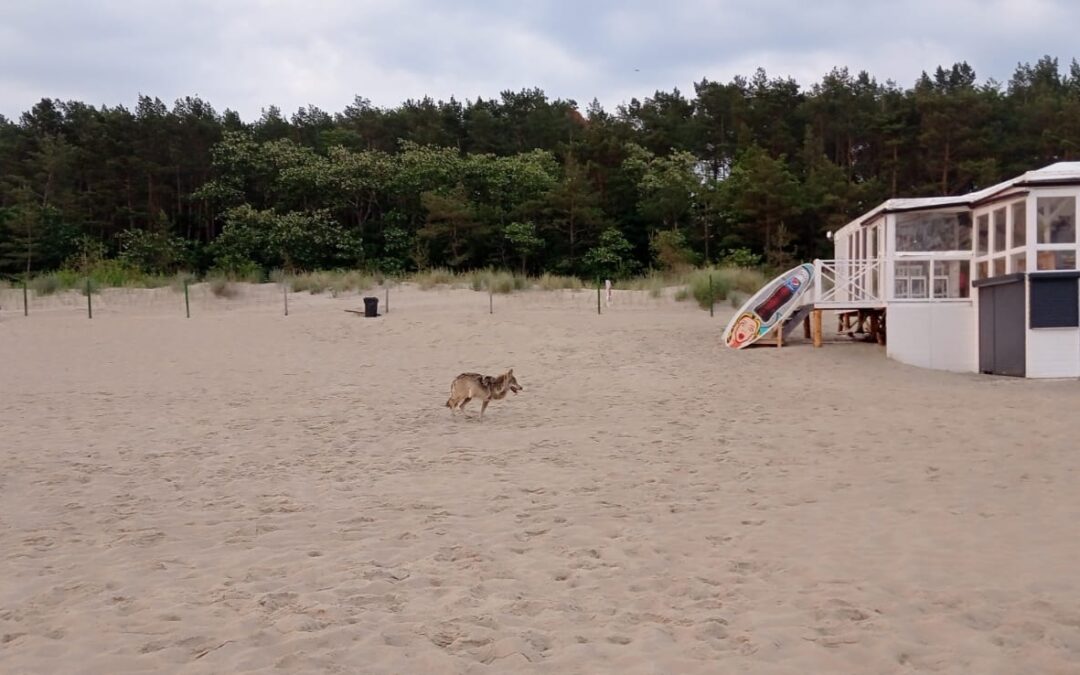A national park in Poland is searching for a three-legged wolf it had in its care after a car accident but which escaped by digging a tunnel out of its enclosure. The young male, named Kamyk (Pebble), has often been spotted by tourists running on local beaches.
Staff from Woliński National Park in northwest Poland say that, although the wolf is not aggressive towards humans, it should not be fed. They have also urged anyone who spots the animal to notify the park authorities.
Niezwykłe nagranie wilka Kamyka i kilka gorzkich słów. Kamyk uciekł z zagrody w Wolińskim PN. W 2020 uderzyło w niego auto autem. Miał 5 m-cy, w rowie przeleżał kilka dni, aż zobaczył go kierowca Tira. Sądził, że to pies i na miejsce wezwana została Fundacja Dzika Ostoja 🧵 1/6👇 pic.twitter.com/sgJC660BAK
— Robert Maślak (@RobertMaslak) July 27, 2023
In 2020, aged around five months, Kamyk was found in a roadside ditch after, most probably, being hit by a car. The wolf was not moving, and his wounds were infested with fly larvae, suggesting he might have been lying on the side of the road for a couple of days.
The animal, which was initially mistaken for a dog, was reported to a local dog welfare organisation and then transported to a veterinarian in the city of Szczecin, where he underwent an operation.
The operation on his back legs, widely reported by local media at the time as the first such procedure in Poland, was successful. But Kamyk, who was named after the town of Kamień Pomorski (meaning Pomeranian Stone) near where he was found, started gnawing one of his front paws.
It turned out that the nerve plexuses had been crushed during the accident. The limb was inert and the wolf treated it like a foreign body that it was trying to get rid of.
Following an unsuccessful drug treatment, the vets decided to amputate the limb. This meant that the wolf would not be able to return to the wild, ending the initial enthusiasm after the first successful operation, said Michał Kudawski of the Dzika Ostoja Animal Foundation, which took the wolf in.
“Having to amputate the front limb derailed the joy of this undoubted success. If we had known beforehand that the nerves of the forelimb had been destroyed, we would have opted for putting him down,” he told the OKO.press news service at the time.
Wildlife experts also criticised the decision to keep the pup alive, warning that, at such a young age, the wolf could quickly become dependent on humans for food and would have no chance of becoming independent, while confinement in a cage would bring him stress.
“I do not support the idea of keeping a terrified, stressed wolf without one paw in a national park enclosure for a dozen years, let alone showing it to visitors, ” scientist and wolf expert Sabina Nowak told OKO.press. “It perpetuates the idea that rescuing at all costs and confining large carnivores in captivity is an exemplary action.”
A pack of wolves has settled in a national park on the outskirts of Warsaw, just 20km from the city centre.
The animals have successfully re-emerged from near extinction in Poland, having been culled en masse before and after WWII https://t.co/BPNpIz3jmq
— Notes from Poland 🇵🇱 (@notesfrompoland) September 7, 2020
Kudawski explained that they had to make the decision to rescue the wolf quickly, before the foundation could contact an association specialising in helping wolves.”Now that we’ve saved Kamyk’s life, we want to try to pave a future for him in the enclosure,” he said in 2020.
“We will be consulting with a behaviourist and other wolf experts,” added Kudawski. “We want to find out if it could be arranged in such a way that it could serve an educational purpose. So that people can see the wolf up close, as happens, for example, in Scandinavian wolf parks.”
Kamyk stayed at the Dzika Ostoja Foundation for a year. However, wolf experts criticised the conditions in which the animal was kept, reports the Gazeta Wyborcza daily.
Finally, in autumn 2021, he was placed in a small enclosure in the Wolin National Park at the back of the bison runway. The wolf tried repeatedly to break free by, for example, destroying the wire fence. His caretakers tried to upgrade the enclosure by reenforcing the walls. So Kamyk started digging.
W 2020 blaszane ściany zastąpiła solidna siatka. Wybieg w Wolińskim PN nie spełniał w żadnym stopniu potrzeb gatunkowych wilka. Kamyk zaczął kopać. Wilk za pomocą jednej łapy zrobił 1-metrowy podkop i uciekł. Park uzyskał środki na budowę nowego, większego wybiegu. 4/6👇 pic.twitter.com/YWCTTNJZY0
— Robert Maślak (@RobertMaslak) July 27, 2023
Workers would fill in newly dug holes and secure them with logs, but the ground was getting looser and looser, so it was getting easier for the wolf to keep digging. Finally, Kamyk dug under the substructure of the enclosure, which was buried a metre deep, and escaped on 15 April this year
“We thought it was unbelievable, he doesn’t have one front paw after all…We did not expect it to be able to dig a hole a metre deep,” Wioletta Nawrocka, director of the Woliński National Park, told Gazeta Wyborcza.
However, Nowak is not surprised. “Every wolf that has ever lived in the wild, regardless of age, will want to escape from captivity because he remembers perfectly the time when he was free,” she says, adding that only a wolf puppy raised by humans from 2-3 weeks of age is able to accept captivity

Notes from Poland is run by a small editorial team and published by an independent, non-profit foundation that is funded through donations from our readers. We cannot do what we do without your support.
Main image credit: miedzyzdroje.pl

Alicja Ptak is senior editor at Notes from Poland and a multimedia journalist. She previously worked for Reuters.



















